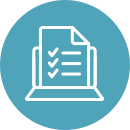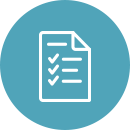
Workbooks & e-Books
-
Contains 2 Component(s)
AAST Water Bottle
AAST Water Bottle - Stay refreshed and represent your profession with the AAST Water Bottle. Designed for durability and convenience, this sleek, lightweight bottle is perfect for busy sleep technologists on the move. Whether you're at the clinic, at a conference, or on a quick break, this bottle helps you stay hydrated in style.
- Introduction
- Anatomy and Physiology of the Respiratory System
- CPAP & BPAP
- AVS
- NPPV - AVAPS
- AVAPS-AE
- Knowledge Check Answers
AAST Water Bottle - Stay refreshed and represent your profession with the AAST Water Bottle. Designed for durability and convenience, this sleek, lightweight bottle is perfect for busy sleep technologists on the move. Whether you're at the clinic, at a conference, or on a quick break, this bottle helps you stay hydrated in style.
-
Register
- Non-member - $20
- Member - $10
- More Information
-
Contains 2 Component(s)
AAST Mug
AAST Mug $20 NM | $10 M Start your day the right way—with the perfect cup in hand. The AAST Mug combines style and function, offering a sleek, durable design that’s ideal for home, office, or on-the-go use. Crafted from high-quality ceramic, this cup features a glossy white finish with the official AAST logo, making it a proud addition to any sleep technologist’s collection.
AAST Mug $20 NM | $10 M Start your day the right way—with the perfect cup in hand. The AAST Mug combines style and function, offering a sleek, durable design that’s ideal for home, office, or on-the-go use. Crafted from high-quality ceramic, this cup features a glossy white finish with the official AAST logo, making it a proud addition to any sleep technologist’s collection.
-
Register
- Non-member - $20
- Member - $10
- More Information
-
Register
-
Contains 3 Component(s)
AAST 2025 Annual Meeting T-Shirt
AAST 2025 Annual Meeting T-Shirt - Celebrate connection, community, and professional pride with the official AAST 2025 Annual Meeting T-Shirt. Whether you're attending in person or showing your support from afar, this commemorative shirt is a must-have keepsake. Made with soft, breathable fabric and designed for everyday comfort, it’s perfect for showcasing your role in the sleep technology profession. Available in S-M-L-XL-XXL-XXXL, limited quantities)
AAST 2025 Annual Meeting T-Shirt - Celebrate connection, community, and professional pride with the official AAST 2025 Annual Meeting T-Shirt. Whether you're attending in person or showing your support from afar, this commemorative shirt is a must-have keepsake. Made with soft, breathable fabric and designed for everyday comfort, it’s perfect for showcasing your role in the sleep technology profession. Available in S-M-L-XL-XXL-XXXL, limited quantities)
-
Register
- Non-member - $30
- Member - $15
- More Information
-
Register
-
Contains 2 Component(s)
A companion piece to the Advanced Sleep Titration recorded modules, this 126-page spiral-bound workbook will assist sleep health professionals gain a thorough understanding of cardiorespiratory anatomy and physiology and enhancement of your Positive Airway Pressure (PAP) titration skills.
This valuable reference for both new and seasoned sleep technologists performing advanced PAP titration. Topics included in preview on next tab. Each chapter also includes questions as a check for knowledge comprehension with an answer bank.
- Introduction
- Anatomy and Physiology of the Respiratory System
- CPAP & BPAP
- AVS
- NPPV - AVAPS
- AVAPS-AE
- Knowledge Check Answers
This valuable reference for both new and seasoned sleep technologists performing advanced PAP titration. Topics included in preview on next tab. Each chapter also includes questions as a check for knowledge comprehension with an answer bank.
-
Register
- Non-member - $105
- Member - $80
- More Information
-
Contains 2 Component(s)
A companion piece to the Fundamentals of Virtual Patient Monitoring recorded modules, this 107-page spiral-bound workbook is ideally suited for those who are preparing for a role in patient care or the certification in Clinical Sleep Health (CCSH) credential. The material focuses on identifying best practices for patient interviewing and assessment, and developing the communication skills that are critical for patient management, a role that is increasingly moving to the CCSH.
Utilizing data downloads and report tools for successful patient and program management including navigating the patient record and assessing treatment compliance are key components of patient management. Patient scenarios provide an opportunity for practical application of assessment skills critical to the CCSH role. Each chapter also includes questions as a check for knowledge comprehension with an answer bank.
- Introduction
- Section: Building a Remote Patient Monitoring Coaching Program
- Section: Care Orchestrator Report Development Tools for Successful Patient and Program Management
- Section: Data Management of Patients with Sleep Disordered Breathing
- Section: Remote Patient Monitoring Scenarios
- Section: Knowledge Check Answer Keys
Utilizing data downloads and report tools for successful patient and program management including navigating the patient record and assessing treatment compliance are key components of patient management. Patient scenarios provide an opportunity for practical application of assessment skills critical to the CCSH role. Each chapter also includes questions as a check for knowledge comprehension with an answer bank.
-
Register
- Non-member - $105
- Member - $80
- More Information
-
Contains 1 Component(s)
This 132-page e-workbook is intended to provide step-by-step instructions for collecting sleep study data from patients and includes suggestions for putting the patient at ease.
For those new to sleep technology, this e-workbook should be used in addition to other forms of learning also consistent with the AASM Manual for the Classification of Sleep and Associated Events. This is not intended as a scoring manual.
- Introduction
- Reviewing the Patient Chart
- Welcoming the Patient to the Sleep Center
- Preparing the Patient for Electrode Application and Applying the Electrodes
- Testing Electrode Application
- Documentation and Maintaining Recording Quality
- Sleep Center Emergencies and Interventions
- Ending the Sleep Study
For those new to sleep technology, this e-workbook should be used in addition to other forms of learning also consistent with the AASM Manual for the Classification of Sleep and Associated Events. This is not intended as a scoring manual.
-
Register
- Non-member - $95
- Member - $75
- More Information
-
Contains 2 Component(s)
This 132-page spiral-bound workbook is intended to provide step-by-step instructions for collecting sleep study data from patients and includes suggestions for putting the patient at ease.
For those new to sleep technology it should be used in addition to other forms of learning also consistent with the AASM Manual for the Classification of Sleep and Associated Events. This is not intended as a scoring manual.
- Introduction
- Reviewing the Patient Chart
- Welcoming the Patient to the Sleep Center
- Preparing the Patient for Electrode Application and Applying the Electrodes
- Testing Electrode Application
- Documentation and Maintaining Recording Quality
- Sleep Center Emergencies and Interventions
- Ending the Sleep Study
For those new to sleep technology it should be used in addition to other forms of learning also consistent with the AASM Manual for the Classification of Sleep and Associated Events. This is not intended as a scoring manual.
-
Register
- Non-member - $105
- Member - $80
- More Information
-
Contains 2 Component(s)
A companion piece to the Advanced Pediatrics recorded modules, this 108-page spiral-bound workbook will assist sleep health professionals become more proficient in pediatric care done in the sleep center.
Each chapter also includes questions as a check for knowledge comprehension with an answer bank.
- Introduction
- Section: Pediatric Polysomnography
- Section: Pediatric Scoring
- Section: Pediatric Sleep Development
- Section: Pediatric Treatment Options and Guidelines
- Section: Pediatric Insomnia and Circadian Rhythm Disorders
- Section: Pediatric Parasomnias and Hypersomnias
- Section: Sleep and Medical Disorders: Special Populations
- Section: Addendum: Supplemental Materials and References
- Section: Knowledge Check Answer Keys
Each chapter also includes questions as a check for knowledge comprehension with an answer bank.
-
Register
- Non-member - $105
- Member - $80
- More Information
-
Contains 2 Component(s)
A companion piece to the Fundamentals of EKG recorded modules, this 73-page spiral-bound workbook will assist sleep health professionals become more proficient in EKG specific to polysomnography.
A systematic analysis is provided for each abnormality in a case study format. Each chapter also includes questions as a check for knowledge comprehension with an answer bank.
- Introduction
- Section: Cardiac Anatomy and Physiology
- Section: Cardiac Arrhythmias
- Section: Arrhythmia Challenges
- Section: Knowledge Check Answer Keys
A systematic analysis is provided for each abnormality in a case study format. Each chapter also includes questions as a check for knowledge comprehension with an answer bank.
-
Register
- Non-member - $105
- Member - $80
- More Information
-
Contains 1 Component(s)
A companion piece to the Fundamentals of Virtual Patient Monitoring recorded modules, this 107-page e-workbook is ideally suited for those who are preparing for a role in patient care or the certification in Clinical Sleep Health (CCSH) credential. The material focuses on identifying best practices for patient interviewing and assessment, and developing the communication skills that are critical for patient management, a role that is increasingly moving to the CCSH.
Utilizing data downloads and report tools for successful patient and program management including navigating the patient record and assessing treatment compliance are key components of patient management. Patient scenarios provide an opportunity for practical application of assessment skills critical to the CCSH role. Each chapter also includes questions as a check for knowledge comprehension with an answer bank.
- Introduction
- Section: Building a Remote Patient Monitoring Coaching Program
- Section: Care Orchestrator Report Development Tools for Successful Patient and Program Management
- Section: Data Management of Patients with Sleep Disordered Breathing
- Section: Remote Patient Monitoring Scenarios
- Section: Knowledge Check Answer Keys
Utilizing data downloads and report tools for successful patient and program management including navigating the patient record and assessing treatment compliance are key components of patient management. Patient scenarios provide an opportunity for practical application of assessment skills critical to the CCSH role. Each chapter also includes questions as a check for knowledge comprehension with an answer bank.
-
Register
- Non-member - $95
- Member - $75
- More Information
-
Contains 1 Component(s)
A companion piece to the Fundamentals of EKG recorded modules, this 73-page e-workbook will assist sleep health professionals become more proficient in EKG specific to polysomnography.
A systematic analysis is provided for each abnormality in a case study format. Each chapter also includes questions as a check for knowledge comprehension with an answer bank.
- Introduction
- Section: Cardiac Anatomy and Physiology
- Section: Cardiac Arrhythmias
- Section: Arrhythmia Challenges
- Section: Knowledge Check Answer Keys
A systematic analysis is provided for each abnormality in a case study format. Each chapter also includes questions as a check for knowledge comprehension with an answer bank.
-
Register
- Non-member - $95
- Member - $75
- More Information
-
Contains 1 Component(s)
A companion piece to the Advanced Sleep Titration recorded modules, this 126-page e-workbook will assist sleep health professionals gain a thorough understanding of cardiorespiratory anatomy and physiology and enhancement of your Positive Airway Pressure (PAP) titration skills.
This valuable reference is for both new and seasoned sleep technologists performing advanced PAP titration. Each chapter also includes questions as a check for knowledge comprehension with an answer bank.
- Introduction
- Anatomy and Physiology of the Respiratory System
- CPAP & BPAP
- AVS
- NPPV - AVAPS
- AVAPS-AE
- Knowledge Check Answers
This valuable reference is for both new and seasoned sleep technologists performing advanced PAP titration. Each chapter also includes questions as a check for knowledge comprehension with an answer bank.
-
Register
- Non-member - $95
- Member - $75
- More Information
-
Contains 1 Component(s)
A companion piece to the Advanced Pediatrics Sleep recorded modules, this 108-page e-workbook will assist sleep health professionals become more proficient in pediatric care done in the sleep center.
Each chapter also includes questions as a check for knowledge comprehension with an answer bank.
- Introduction
- Section: Pediatric Polysomnography
- Section: Pediatric Scoring
- Section: Pediatric Sleep Development
- Section: Pediatric Treatment Options and Guidelines
- Section: Pediatric Insomnia and Circadian Rhythm Disorders
- Section: Pediatric Parasomnias and Hypersomnias
- Section: Sleep and Medical Disorders: Special Populations
- Section: Addendum: Supplemental Materials and References
- Section: Knowledge Check Answer Keys
Each chapter also includes questions as a check for knowledge comprehension with an answer bank.
-
Register
- Non-member - $95
- Member - $75
- More Information
-
Contains 2 Component(s)
A companion piece to the CCSH Designated Education Program recorded modules, this 78-page e-workbook includes information on learning goals; general patient education requirements; discussion points for the first visit after diagnosis; key elements of follow-up visits; documentation using a standardized care plan; and a list of references for additional information.
Each chapter also includes questions as a check for knowledge comprehension with an answer bank for a total of 40 knowledge assessment questions with access to an answer key. An example case study is also included.
- Introduction: The Clinical Sleep Health Professional
- The Technologist’s Path to Sleep Care Management
- Sleep Basics
- Evaluation of Sleep Disorders
- Patient Follow-Up and Management for the CCSH
- Patient Education and Motivation
- Sleep in Special Populations
- Clinical Presentation of Sleep Disorders
- Service Management
- Developing Multidisciplinary Programs
- The Future of Sleep Medicine and the CCSH Role
Each chapter also includes questions as a check for knowledge comprehension with an answer bank for a total of 40 knowledge assessment questions with access to an answer key. An example case study is also included.
-
Register
- Non-member - $95
- Member - $75
- More Information
| Access Date | Quiz Result | Score | Actions |
|---|







